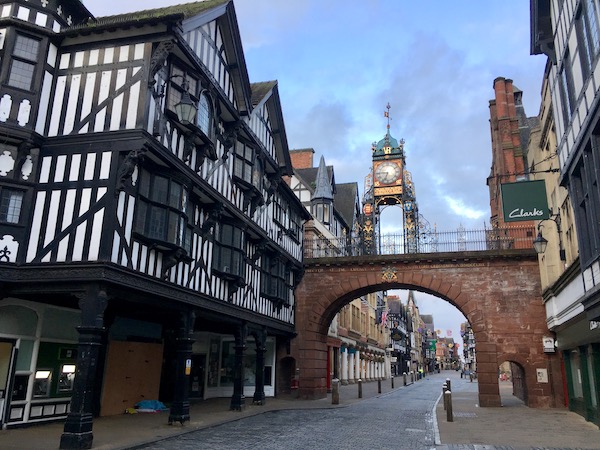Chester
The City of Chester has a rich and fascinating history, from its beginnings as a Roman fortress 2000 years ago to the vibrant modern city of today. Popular attractions include the city walls and gates, the Cross (where four Roman streets converge and the Town Crier delivers proclamations), the largest Roman amphitheatre in Britain, Roman Gardens, the magnificent Cathedral, the unique Tudor Rows (covered galleries of shops), the Eastgate Clock and the River Dee.

Chester is a year round destination offering a lively cafe bar and restaurant culture with vibrant entertainment. Ideally located as a touring base, atmospheric Chester is within an hour’s drive of Manchester and Liverpool. It is also a great base for exploring North Wales and the Cheshire countryside.
Roman Chester
Some two thousand years ago, the Romans chose a site for a fortress on a low sandstone hill overlooking the estuary of the River Dee and named the site ‘Deva’. This was the beginning of Chester. Deva, as it was known to the Romans, became the headquarters for the Twentieth Legion, one of the three Roman Legions stationed in Britain. During the Roman occupation of Britain, Chester was predominantly a military settlement but a prosperous community of merchants and tradesmen developed outside of the walls of the Roman fortress. Exactly when the Romans left Chester is unknown but may have been in the early fifth century.
Medieval Chester
Evidence has been found of a civilian settlement within the walls from the ninth century. It was around this time that the bones of St. Werburgh are said to have been brought to Chester by the nuns of Hanbury. In the early tenth century, Ethelflaed, Lady of the Mercians is said to have extended the walls of the Roman Fortress on the south and west. In 970AD a Royal mint was established at Chester and in 973 King Edgar is said to have been rowed on the Dee by vassal kings. There is evidence of a flourishing community from the tenth century which probably derived its wealth from trade with Scandinavian settlements on the Wirral and in North Wales, and from trade with Ireland.
In medieval times, life in Chester was controlled by the castle, the church and its citizens. After the Norman Conquest of 1066, William I granted the earldom of Chester to Hugh of Avranches in 1070, and Chester Castle became the centre of an administration that was almost independent of the royal government. Chester also became the base from which numerous campaigns were fought against the Welsh. The last Norman earl of Chester was John the Scot. When John the Scot died in 1237, the earldom of Chester reverted to the Crown. In 1254 the earldom was granted by Henry III to his son Prince Edward on the occasion of the Prince’s marriage to Eleanor of Castile. Since then, with the exception of 1264 to 1265 when Simon de Montfort held the earldom of Chester, it has usually been conferred on the male heir of the throne. In 1969, Prince Charles was invested at Caernarfon as Prince of Wales and Earl of Chester.
It would have been difficult to escape the influence of the church in Chester during the medieval period. The principal representative of the church was the Benedictine abbey founded by Earl Hugh in 1093. The abbey was in frequent dispute with the citizens over matters of trade.
Chester Mystery Plays
A main event of the medieval calendar was the performance of the Chester cycle of Mystery plays, which probably evolved in the last quarter of the fourteenth century, and were performed by the craft guilds. The performances took place in the open air on carts around the feast of Corpus Christi, later at Whitsun. The carts were dragged around the city, each company attempting to surpass the others with the magnificence of their production.
Chester and commerce
The port in Chester played an important role in the development as a centre of commerce. A lot wealth was acquired by the citizens by their trading activities. Some of the wealth earned from trading activities was used to buy rights and privileges from the king and earls of Chester. In the first city charter dated between 1175 and May 1176, Henry II confirmed trading rights in Dublin, and between 1190 and 1193, Ranulph the 6th earl of Chester confirmed the citizens’ guild merchant. This gave them control of trade within the city walls, and the right to charge tolls at the city gates. The only occasions when this monopoly lapsed was during the great medieval fairs held at Midsummer and Michaelmas.
The late thirteenth and fourteenth centuries was the most prosperous time for the port of Chester, when it had the status of being one of the busiest ports in the country. Chester had become a cosmopolitan city with ships arriving from the Baltic, Ireland, France, Spain, Portugal and the Low Countries. In 1354, the Black Prince as Earl of Chester, granted the mayor Admiralty power over the River Dee. However, towards the end of medieval period, the Dee began to silt up and made navigation of the Dee by ships more and more difficult. Several attempts were made to to preserve and improve the navigation. In 1699 the city was empowered by an Act of Parliament to raise revenue for the improvement of navigation and a new channel was cut to Chester in 1735 to 1736. All attempts to improve navigation were unsuccessful and as the port of Chester declined, its rival Liverpool, which was a relatively obscure city in the Middle Ages, gained importance.
